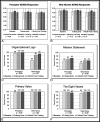Implementation of an Enculturation Toolkit for New Nurses During Unit Onboarding
- PMID: 38512084
- PMCID: PMC11723494
- DOI: 10.1097/NNA.0000000000001414
Implementation of an Enculturation Toolkit for New Nurses During Unit Onboarding
Abstract
Objective: This quality improvement project targeted an enculturation gap among new nurses by assembling and piloting an Enculturation Toolkit.
Background: Enculturation of new nurses contributes to engagement, performance, sense of belonging, and retention. During the COVID-19 pandemic, orientation was shortened, virtual, and asynchronous, creating a gap in enculturation.
Methods: New nurses and their preceptors were surveyed at baseline, 2 to 3 months, and 4 to 5 months to measure engagement and enculturation using the Meaning and Joy in Work Questionnaire (MJWQ) and questions about the history and values of the organization.
Results: Initial MJWQ responses were high and sustained throughout the study period. Participants demonstrated increased knowledge of the organization's mission statement and logo. New nurses rated the toolkit activities favorably, with an average score of 4.6 out of 5.
Conclusions: An Enculturation Toolkit was effective in improving knowledge about the organization and sustaining engagement and belonging.
Copyright © 2024 The Author(s). Published by Wolters Kluwer Health, Inc.
Conflict of interest statement
The authors declare no conflicts of interest.
Figures


Similar articles
-
A model of occupational stress to assess impact of COVID-19 on critical care and redeployed nurses: a mixed-methods study.Health Soc Care Deliv Res. 2024 Dec;13(23):1-32. doi: 10.3310/PWRT8714. Health Soc Care Deliv Res. 2024. PMID: 39708055
-
"Should I stay or should I go?" Nurses' perspectives about working during the Covid-19 pandemic's first wave in the United States: A summative content analysis combined with topic modeling.Int J Nurs Stud. 2022 Jul;131:104256. doi: 10.1016/j.ijnurstu.2022.104256. Epub 2022 Apr 20. Int J Nurs Stud. 2022. PMID: 35544991 Free PMC article.
-
Rapid, point-of-care antigen tests for diagnosis of SARS-CoV-2 infection.Cochrane Database Syst Rev. 2022 Jul 22;7(7):CD013705. doi: 10.1002/14651858.CD013705.pub3. Cochrane Database Syst Rev. 2022. PMID: 35866452 Free PMC article.
-
Sexual Harassment and Prevention Training.2024 Mar 29. In: StatPearls [Internet]. Treasure Island (FL): StatPearls Publishing; 2025 Jan–. 2024 Mar 29. In: StatPearls [Internet]. Treasure Island (FL): StatPearls Publishing; 2025 Jan–. PMID: 36508513 Free Books & Documents.
-
Antibody tests for identification of current and past infection with SARS-CoV-2.Cochrane Database Syst Rev. 2022 Nov 17;11(11):CD013652. doi: 10.1002/14651858.CD013652.pub2. Cochrane Database Syst Rev. 2022. PMID: 36394900 Free PMC article.
References
-
- Lu R, Chatman J, Goldbert A, Srivastava S. Situated cultural fit: value congruence, perceptual accuracy, and the interpersonal transmission of culture [published online March 3, 2019]. https://www.gsb.stanford.edu/faculty-research/working-papers/situated-cu.... Accessed August 26, 2022.
-
- Schein EH. Organizational culture. Am Psychol. 1990;45(2):109–119. 10.1037/0003-066X.45.2.109. - DOI
-
- Srivastava SB, Goldberg A, Manian VG, Potts C. Enculturation trajectories: language, cultural adaptation, and individual outcomes in organizations. Manag Sci. 2018;64(3):1348–1364. 10.1287/mnsc.2016.2671. - DOI
MeSH terms
LinkOut - more resources
Full Text Sources
Medical
Miscellaneous

